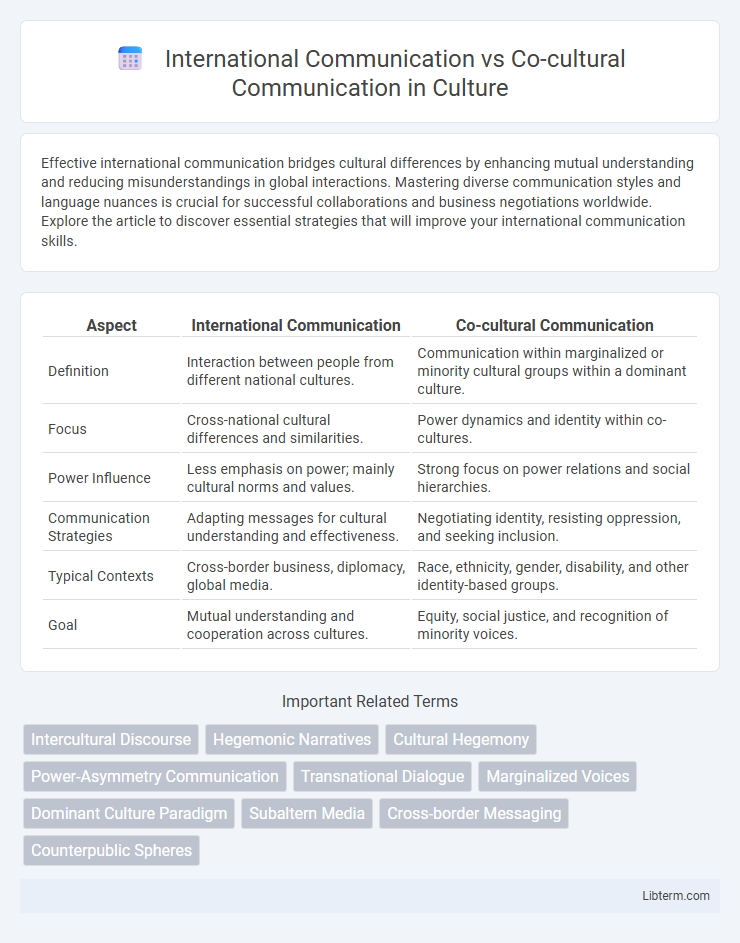Effective international communication bridges cultural differences by enhancing mutual understanding and reducing misunderstandings in global interactions. Mastering diverse communication styles and language nuances is crucial for successful collaborations and business negotiations worldwide. Explore the article to discover essential strategies that will improve your international communication skills.
Table of Comparison
| Aspect | International Communication | Co-cultural Communication |
|---|---|---|
| Definition | Interaction between people from different national cultures. | Communication within marginalized or minority cultural groups within a dominant culture. |
| Focus | Cross-national cultural differences and similarities. | Power dynamics and identity within co-cultures. |
| Power Influence | Less emphasis on power; mainly cultural norms and values. | Strong focus on power relations and social hierarchies. |
| Communication Strategies | Adapting messages for cultural understanding and effectiveness. | Negotiating identity, resisting oppression, and seeking inclusion. |
| Typical Contexts | Cross-border business, diplomacy, global media. | Race, ethnicity, gender, disability, and other identity-based groups. |
| Goal | Mutual understanding and cooperation across cultures. | Equity, social justice, and recognition of minority voices. |
Introduction to International and Co-cultural Communication
International communication examines interactions between individuals from different nations, emphasizing cultural, social, and linguistic diversity on a global scale. Co-cultural communication explores communication patterns among marginalized groups within a dominant cultural context, focusing on power dynamics, identity, and adaptation strategies. Understanding both fields is essential for effective intercultural competence and navigating complex social environments.
Defining International Communication
International communication involves the exchange of information across national boundaries, emphasizing interactions between individuals or groups from different countries with distinct cultural, political, and social contexts. It encompasses the challenges of language barriers, cultural nuances, and differing communication styles that impact global diplomacy, business, and media. Defining international communication requires understanding its role in fostering cross-cultural understanding and navigating geopolitical complexities.
Understanding Co-cultural Communication
Understanding co-cultural communication involves recognizing how marginalized groups interact within dominant societal frameworks, emphasizing the negotiation of identities and power dynamics. It highlights the strategies co-cultural individuals use to express themselves while navigating cultural exclusion and assimilation pressures. This communication differs from international communication by focusing on intra-national, group-specific interactions rather than intercultural exchanges between distinct nations.
Key Differences Between International and Co-cultural Communication
International communication involves interactions between people from different nations, emphasizing cultural, linguistic, and national identity differences, while co-cultural communication occurs within a dominant culture among marginalized or minority groups. Key differences include scope, with international communication crossing national borders, whereas co-cultural communication focuses on power dynamics and group identity within a single society. International communication highlights global cultural diversity, contrasting with co-cultural communication's focus on negotiation of identity and inclusion within dominant societal structures.
Cultural Identity and Its Influence
Cultural identity plays a pivotal role in international communication by shaping individuals' perceptions, values, and communication styles across different nations. In co-cultural communication, cultural identity influences how marginalized or non-dominant groups navigate dominant societal norms, assert their voices, and negotiate meaning within shared cultural contexts. Both forms of communication highlight the dynamic interplay between cultural identity and context-specific adaptation, significantly affecting message interpretation and relational outcomes.
Language Barriers and Communication Styles
International communication often faces language barriers due to differences in native languages, dialects, and accents, which can lead to misunderstandings and misinterpretations in message delivery. Communication styles vary significantly between cultures, ranging from high-context, indirect communication prevalent in East Asian societies to low-context, direct communication common in Western cultures. Co-cultural communication involves navigating these language and stylistic differences by adapting language use and nonverbal cues to bridge gaps between dominant and marginalized groups within the same society.
Power Dynamics in Communication Contexts
Power dynamics in international communication often reflect global hierarchies, where dominant cultures influence language norms and interaction patterns, creating asymmetrical communication flows. Co-cultural communication highlights how marginalized groups within a dominant culture navigate power imbalances by employing strategies such as non-assertive, assertive, or aggressive communication to negotiate their identities and access to resources. Understanding these dynamics requires analyzing how societal power structures shape communication practices, influencing both intercultural interactions and the agency of co-cultural members.
Case Studies: Real-world Examples
Case studies in international communication reveal challenges in transcultural business negotiations between American and Japanese firms, highlighting differences in communication styles and decision-making processes. Co-cultural communication research examines interactions within dominant and non-dominant groups in the United States, such as the experiences of African American employees navigating workplace microaggressions. These real-world examples underscore the importance of cultural awareness and adaptive communication strategies in diverse social and professional environments.
Overcoming Challenges in Diverse Communication Settings
Overcoming challenges in international communication requires understanding cultural norms, language barriers, and nonverbal cues unique to each country, enhancing clarity and reducing misunderstandings. Co-cultural communication emphasizes navigating power dynamics and social hierarchies within dominant cultural frameworks to foster inclusion and mutual respect. Employing active listening, empathy, and adaptive communication strategies enables effective dialogue across both diverse international and co-cultural contexts.
Future Trends in International and Co-cultural Communication
Future trends in international communication highlight the increasing importance of digital platforms and artificial intelligence in bridging cultural gaps, enabling real-time multilingual interactions and enhancing global collaboration. Co-cultural communication is expected to emphasize inclusive language strategies and adaptive communication styles to address the complexities of diverse identities within larger cultural frameworks. Advances in virtual reality and augmented reality technologies will further transform both international and co-cultural communication by creating immersive environments that foster empathy and nuanced understanding across cultural boundaries.
International Communication Infographic

 libterm.com
libterm.com